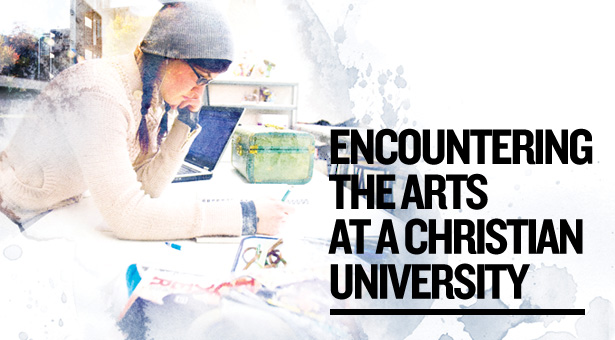
We expect to encounter the arts in museums, concert halls, theatres, and other spaces in our culture set aside for artistic endeavor — even in art classrooms. But what happens when we encounter the arts in the context of a Christian university? How does the unique combination of a grace-filled Christian community and an environment of rigorous learning shape our encounters with art?
Response asked Seattle Pacific University faculty members Laura Lasworth and Brian Bantum to reflect upon the encounter with art.
Encountering Grace: Art in Community
By Laura Lasworth, SPU Professor of Art
 When we look at a work of art in community, we hope the art might provide a neutral zone for diverse opinion and for conversation to occur. Different spectators may have different thoughts or reactions when encountering the same work of art. Art can ignite an honest, engaged, thoughtful exchange. The university allows for this by the ritual of university life. Students walk through the gallery en route to their art classes. And in our art classes at Seattle Pacific University, through lecture and creative projects, we go deeper in interpreting and understanding art.
When we look at a work of art in community, we hope the art might provide a neutral zone for diverse opinion and for conversation to occur. Different spectators may have different thoughts or reactions when encountering the same work of art. Art can ignite an honest, engaged, thoughtful exchange. The university allows for this by the ritual of university life. Students walk through the gallery en route to their art classes. And in our art classes at Seattle Pacific University, through lecture and creative projects, we go deeper in interpreting and understanding art.
In the context of a Christian university, however, art also provides an opportunity to enhance our faith. I believe, if art is truly Christian, it's under a mandate to "make things new," including how we present God in our world, through artistic means. When God says, "See, I am making all things new," Christian artists hear a call to make all things new as creators.
The university experience provides young artists the gift of time and resources to help them find their unique vision and voice in response to that call. If we're genuinely, truly making things new, they may be unfamiliar, they may be hard to look at, they may be uncomfortable for people. And yet, if the art has been made in cooperation with the Holy Spirit, we may very well be encountering grace in that discomfort.
A good work of art has the ability to provide us with a personal experience of transformation or reconciliation through an encounter with transcendence, or presence. And in a grace-filled university setting, these personal encounters can become part of a shared experience of faith that helps shape students as human beings and as artists.
Why Theology Needs Art: The Artistic Process as a Way of Understanding
By Brian Bantum, SPU Assistant Professor of Theology
 In beginning to teach theology, especially to undergraduates, I have been struck at how inadequate words often are in conveying the encounter of God and humanity. The paradox of God's transcendence and God's presence in Christ, is not merely an intellectual problem. Instead, theology struggles with the Word made flesh, material, present. The Word was seen, touched, heard. Christian theology was born out of an encounter with God made flesh, with a God who was previously thought hidden and unseen.
In beginning to teach theology, especially to undergraduates, I have been struck at how inadequate words often are in conveying the encounter of God and humanity. The paradox of God's transcendence and God's presence in Christ, is not merely an intellectual problem. Instead, theology struggles with the Word made flesh, material, present. The Word was seen, touched, heard. Christian theology was born out of an encounter with God made flesh, with a God who was previously thought hidden and unseen.
In the midst of this tension, the arts invite us into theological imagination, where we use doctrines as tools to imagine and re-imagine the encounter of God with humanity. Theology needs art because art and the artistic process remind us that Christ can never be limited to thoughts or ideas. Reflection upon Christ is about a visible, material life.
When I teach theology, I draw upon artistic images, words, and song, Christian and secular. When we examine how artists represent unseen realities through images we can see or melodies we can hear, our theological struggles become felt and seen in deep and profound ways.
In theology courses, I also ask students to create art that articulates theological claims in order to help them understand doctrines as not only ideas, but also concrete realities. Through the process of creating art, we gain a new, powerful opportunity to see the wonder of these doctrines.
When theology prayerfully draws upon art, it allows us to conceive of theology as an art itself, something created with imagination, and inspired by God's presence touching us.
The arts draw students into both the materiality and the beauty of God's creation, knitting together various disciplines of inquiry. In a Christian university, faculty seek to draw students into their calling as beloved creatures. Teaching, research, and life together serve as icons that point to God's beauty and love. And in a Christian university, we want students to imagine their life and work as both deeply theological and as art, as visible presentations of God's abundant grace and presence in our lives.
